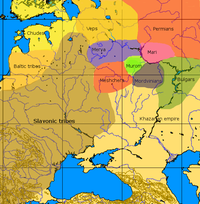
Permians
Encyclopedia

Finno-Ugric peoples
The Finno-Ugric peoples are any of several peoples of Europe who speak languages of the proposed Finno-Ugric language family, such as the Finns, Estonians, Mordvins, and Hungarians...
and include Komis and Udmurts, speakers of Permic languages
Permic languages
Permic languages are a branch of the Uralic language family. They are spoken in the foothills of the Ural Mountains of Russia.* Komi** Komi-Permyak** Komi-Yodzyak ** Komi-Zyryan...
. Formerly the name Bjarmians was also used to describe these peoples. The recent research on the Finno-Ugric substrate in northern Russian dialects however suggests that in Bjarmaland
Bjarmaland
Bjarmaland was a territory mentioned in Norse sagas up to the Viking Age and - beyond - in geographical accounts until the 16th century. The term is usually seen to have referred to the southern shores of the White Sea and the basin of the Northern Dvina River and - presumably - some of the...
there also lived several other Finno-Ugric groups besides the Permians.
The ancestors of the Permians inhabited originally the land called Permia covering the middle and upper Kama River
Kama River
Kama is a major river in Russia, the longest left tributary of the Volga and the largest one in discharge; in fact, it is larger than the Volga before junction....
. Permians split into two groups probably during the 9th century.
The Komis came under the rule of the Novgorod Republic
Novgorod Republic
The Novgorod Republic was a large medieval Russian state which stretched from the Baltic Sea to the Ural Mountains between the 12th and 15th centuries, centred on the city of Novgorod...
in the 13th century and were converted to Orthodox Christianity in the 1360-70s. In 1471-1478 their lands were conquered by the Grand Duchy of Moscow
Grand Duchy of Moscow
The Grand Duchy of Moscow or Grand Principality of Moscow, also known in English simply as Muscovy , was a late medieval Rus' principality centered on Moscow, and the predecessor state of the early modern Tsardom of Russia....
that later became the Tsardom of Russia
Tsardom of Russia
The Tsardom of Russia was the name of the centralized Russian state from Ivan IV's assumption of the title of Tsar in 1547 till Peter the Great's foundation of the Russian Empire in 1721.From 1550 to 1700, Russia grew 35,000 km2 a year...
. In the 18th century the Russian authorities opened the southern parts of the land to colonization and the northern parts became a place to which criminal and political prisoners were exiled.
The Udmurts came under the rule of the Tatars
Tatars
Tatars are a Turkic speaking ethnic group , numbering roughly 7 million.The majority of Tatars live in the Russian Federation, with a population of around 5.5 million, about 2 million of which in the republic of Tatarstan.Significant minority populations are found in Uzbekistan, Kazakhstan,...
, the Golden Horde
Golden Horde
The Golden Horde was a Mongol and later Turkicized khanate that formed the north-western sector of the Mongol Empire...
and the Khanate of Kazan
Khanate of Kazan
The Khanate of Kazan was a medieval Tatar state which occupied the territory of former Volga Bulgaria between 1438 and 1552. Its khans were the patrilineal descendants of Toqa Temür, the thirteenth son of Jochi and grandson of Genghis Khan. The khanate covered contemporary Tatarstan, Mari El,...
until their land was ceded to Russia, and the people where christianized at the beginning of 18th century.

